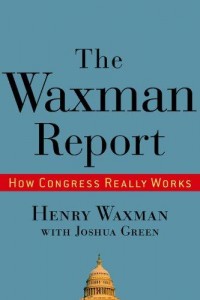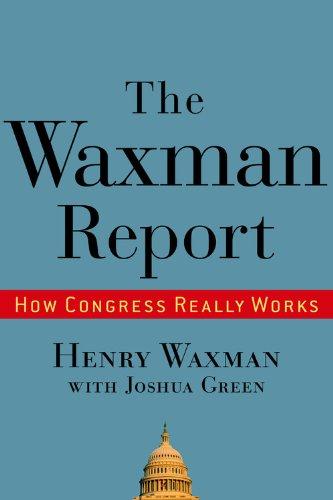 Rep. Henry Waxman (D-Calif.) is the chair of the Energy and Commerce Committee and coauthor of the ACES bill passed by the House in June. Naturally, political observers are curious about his thoughts on the fight to pass climate/energy legislation this year, but in media interviews he tends to be careful, measured, and fairly abstract. He doesn’t do his work in public.
Rep. Henry Waxman (D-Calif.) is the chair of the Energy and Commerce Committee and coauthor of the ACES bill passed by the House in June. Naturally, political observers are curious about his thoughts on the fight to pass climate/energy legislation this year, but in media interviews he tends to be careful, measured, and fairly abstract. He doesn’t do his work in public.
It turns out, however, that Waxman has offered a fairly clear guide to his thinking, and even told us where to find it: it’s in chapter five of his new book, The Waxman Report: How Congress Really Works. (The book is coauthored with writer Josh Green, who wrote a stellar piece on clean energy last month for The Atlantic.)
A brief aside about the book: it’s fantastic, less the primer promised by the title than a series of first-person yarns containing startling measures of suspense, drama, and pathos. It sounds strange to say about a book mostly composed of congressional investigations and hearings, but it’s a real page-turner. And there are victories. No matter your skepticism about government, you will be inspired.
The point of this post isn’t to review the book, though. For that see the The Washington Post and the L.A. Times. This is about chapter five, the battle(s) over the Clean Air Act.
Defense
The CAA was originally passed in 1970 and strengthened in 1977, but when Reagan rolled into D.C. in 1980, killing it was one of his top priorities. He had enormous popularity among the public, universal backing from industry, broad support in Congress, and a willing co-conspirator in Energy and Commerce chairman John Dingell (D-Mich.), who then as now represented the auto industry. It was grim.
Waxman, who chaired the environment subcommittee, launched what was effectively a guerilla campaign. To begin with, he used every procedural trick and delay in the book, trying to slow the juggernaut. When the bill went before the full committee, Waxman offered amendment after amendment seeking fissures in the opposing coalition. As Waxman says, “our strategy was to muster all our strength to deny one industry its favors, and in doing so, set off a chain reaction — if one industry pulled out, others might waver, too, eventually turning the coalition members against one another.” And that’s what happened. The crucial turning point was a toxic air amendment that effectively soured the deal for the chemical industry. It passed by one, shaky, uncertain vote. With that, Reagan’s overwhelmingly favored effort to gut the CAA died.
(Suffice to say, this chapter is illuminating on the subject of why Dingell and Waxman can’t stand each other, and why Waxman felt the need to effectively pull a coup on the committee last year.)
Offense
For the rest of the decade, Waxman methodically built a coalition to strengthen the CAA and address, among other problems, acid rain. Many behind-closed-doors meetings with Midwest Democrats ensued, along with field hearings highlighting the economic benefits of the policy. His effort was defeated in 1983, and again in 1984. Later in 1984 came the devastating explosion at the Bhopal pesticide plant in India, which captured public attention; Waxman jumped on the opportunity to hold a field hearing at a similar plant making similar chemicals (and with similarly few safeguards) in the U.S.
In 1985, yet another ambitious attempt ended up stripped almost bare, leaving only the Toxic Release Inventory, which merely required polluters to disclose their emissions. As it happens, TRI galvanized the debate in a way no one expected. When members of the public found out exactly how much pollution they were breathing, and where it came from, and how their cities compared to other cities, their appetite for pollution control increased markedly.
What Waxman calls the “turning point” was a somewhat obscure amendment fight in 1987, over compliance deadlines. The day before the vote, Dingell and Rep. John Murtha (D-Penn.) publicly predicted an easy defeat of the Waxman/Conte amendment. The following day it passed with a 95 vote margin, an unexpected, resounding win for the growing coalition behind clean air.
By 1989, with Bush I (the self-styled “environmental president”) in office and Sen. George Mitchell (D-Maine) replacing Robert Byrd (D-W.Va.) as Senate majority leader, new regulations seemed inevitable; industry was divided and infighting, scrabbling for deals. Waxman and his allies went straight after Dingell, pushing tougher tailpipe standards, figuring if they got that Dingell would roll on other industries. The two key votes turned out to be Republican Tom Tauke (Iowa), who got some protection for tractors, and conservative Dem Ralph Hall (Texas), who got sheer, cussed persuasion.
Victory
Dingell cracked and made a deal. The unexpected alliance of Waxman and Dingell led to more deals, momentum, some marathon negotiations over acid rain, and ultimately a bill through the House.
What happened next is interesting indeed:
The Bush administration made a key strategic miscalculation that wound up strengthening the law considerably in the final stages of negotiation. Bush officials played an active role in negotiating the Senate bill, but not its House counterpart. Assuming that a weaker bill would emerge from the House, White House negotiators had insisted that the Senate agreement bind the subsequent House-Senate conference, as Dingell and I had agreed to do. By freeing senators to vote as they wished, the administration expected that they would combine the weakest elements of both bills in to the final legislation. Instead, with an election looming, they supported the strongest provisions in both bills, producing a law that was much better than either the House or Senate drafts had been.
Thus: the Clean Air Act amendments of 1990. Here’s what happened next:
Five years after its passage, more than half the U.S. cities that exceeded urban smog standards had come into compliance. Production of ozone-depleting chemicals had dropped by more than 90 percent. Power plant emissions that cause acid rain fell to half their 1980 levels, and at a fraction of the cost industry had predicted. … When fully implemented, the law will prevent tens of thousands of premature deaths, tens of thousands of hospital admissions for respiratory and cardiovascular illnesses, and millions of lost workdays each year.
That strikes me as well worth a decade of fighting.
What can we learn from this tale that’s germane to the fight over climate legislation? I’ll address that in a future post, but please, share your own interpretations in comments.




